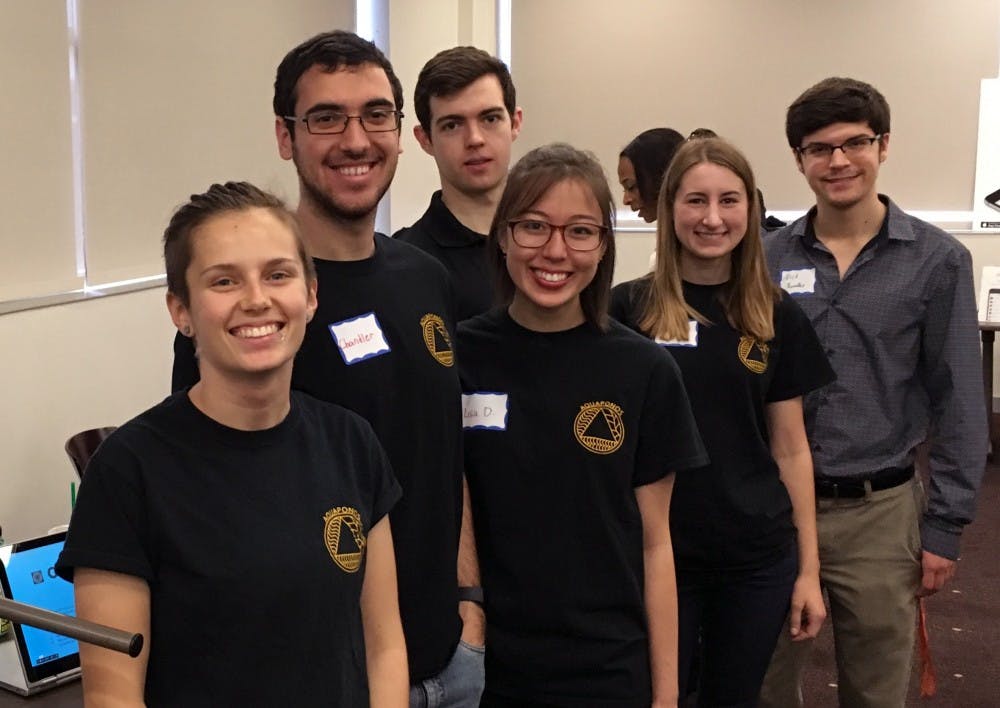The Aquaponos team beamed proudly as they stood beside an orange bucket with a tube sprouting leaves hanging above it. Closer examination revealed that, within the bucket, swam a small number of fish.
"So aquaponics itself is kind of like a happy marriage between fish farming and hydroponics," Veronica Head, Aquaponos' team lead, said. "So in fish farming you have fish and they generate a lot of waste, and normally that's just a pollutant because they don't do anything with that waste, and then in hydroponics you grow plants through water, not soil."
Head said that by siphoning the fish waste through a tube past a bank of plants, the nutrients from the waste are filtered out for use by the plants, and the fresh water is then returned to the tank for use by the fish. It's an idea that originated in ancient times but has found new life with Aquaponos.
"So this originally started as a project that was kind of based around agriculture, health and clean water for Africa, and they were going to use Aquaponos to provide food to this community," Head said. "So we kind of took that idea and branched off from there."
Aquaponos is a team of undergraduate engineering students who started their project through the Fulton school's EPICS program, which encourages students to develop engineering based solutions to social problems and implement them in charitable ways. All the team members are undergraduate engineering students. Since beginning with EPICS, Aquaponos has grown into an independent project with its own goals.
"So we are transitioning from that into a startup because we've sort of finished producing what we needed for our partner in that regard, and we've enjoyed aquaponics enough that we wanted to continue to become a company now," Nick Kandas, Aquaponos' plant expert, said.
Now, the fledgling company's goal is to market itself to restaurants and caterers as the most environmentally sustainable way of maintaining fish and produce.
"A lot of companies are looking at going a more sustainable route, they want more locally grown produce," Kandas said. "Particularly in Arizona, we've seen a lot of restaurants that want that more green, friendly vibe to them, and so there's a lot of interest."
Beyond just offering companies an opportunity to attract the environmentally conscious, Aquaponos has the ability to produce a lot of food with minimal input.
"We can produce high volumes of produce in a limited space," Kandas said. "That's one of the great things about grow towers, is that they do that. They are incredibly space efficient."
This isn't to say that the team hasn't found the process of designing and implementing a fish powered product difficult.
"It never turns out the way it is on paper in real life," Lisa Dietrich said. "So we've had a lot of challenges just actually building the prototype and making the physical manifestation of what we're trying to create."
The team had to replace all of the PVC in their prototype because they found that the material degraded too quickly when exposed to sunlight. This meant that they had to completely rebuild the prototype, causing a bit of a setback.
Dietrich said that, once completed, the team hopes to use the technology to teach the community about the benefits of environmentally friendly agriculture.
"Another direction we're hoping to take this is just educating people about sustainability," Dietrich said. "Our final product, we want to have it in a shipping container, so we're hoping to utilize the inside space to have people come in and learn about sustainability."
Reach the reporter at sdeadric@asu.edu or follow @deadrick_sam on Twitter.
Like The State Press on Facebook and follow @statepress on Twitter.




